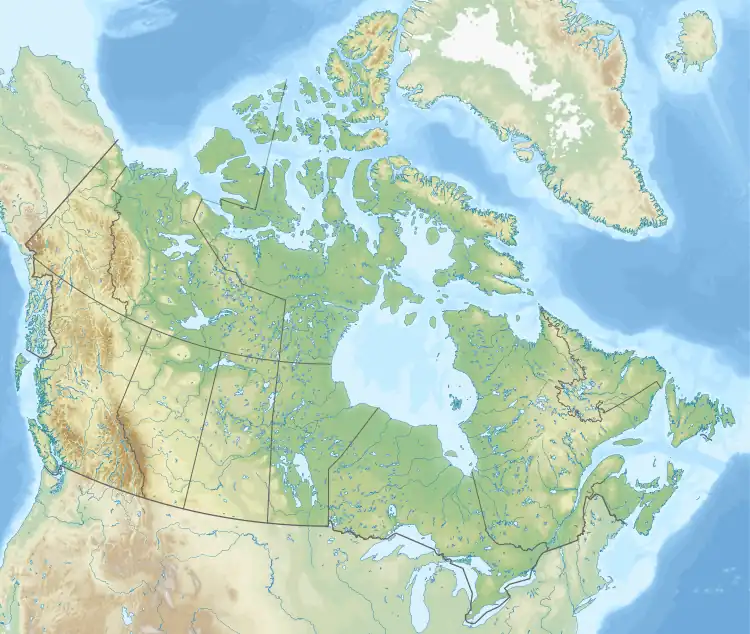| Dunvegan Formation | |
|---|---|
| Stratigraphic range: Cenomanian ~ | |
 Dunvegan Sandstone | |
| Type | Geological formation |
| Underlies | Smoky Group |
| Overlies | Fort St. John Group (Shaftesbury Formation) |
| Thickness | up to 380 feet (120 m)[1] |
| Lithology | |
| Primary | Sandstone |
| Other | Shale |
| Location | |
| Coordinates | 55°55′14″N 118°37′55″W / 55.92043°N 118.63203°W |
| Region | Northeast Northwest |
| Country | |
| Type section | |
| Named for | Dunvegan, Alberta |
| Named by | George Mercer Dawson |
| Year defined | 1881 |
 Dunvegan Formation (Canada) | |
The Dunvegan Formation is a stratigraphical unit of Cenomanian age in the Western Canadian Sedimentary Basin.
It takes the name from the settlement of Dunvegan, Alberta, and was first described in an outcrop on Peace River near Dunvegan by George Mercer Dawson in 1881.[2]
Lithology
The Dunvegan Formation is composed of marine, and deltaic sandstone with thin shale interbeds in the Peace River Country. East of Dunvegan, Alberta it is of marine origin, and in its western reaches in British Columbia it was deposited in a continental facies, where the sandstone becomes more conglomeratic. During Dunvegan time, a brackish water environment was present in the Wapiti River area and south of Grande Prairie, where the formation is porous.
Hydrocarbon production
The Dunvegan Formation had an initial established recoverable oil reserve of 9.9 million m³, with 3.1 million m³ already produced as of 2008.[3] Gas reserves totaled 18.7 million m³, with 4.5 million m³ already produced.[4]
Distribution
The Dunvegan Formation is 180 feet (50 m) thick in its type locality in Peace River Country and up to 380 feet (120 m) in the sub-surface of the Canadian Rockies foothills. It occurs south of Fort Nelson and the Liard River in north-east British Columbia, thins out south of the Peace River Country. South of the Athabasca River, the Dunvegan grades laterally into the Blackstone Formation.
The Dunvegan Formation is exposed in outcrop along and near the Peace River east of the foothills, in the Peace River Country and the Chinchaga area, as well as patches in north-western Alberta and south of the Caribou Mountains.
Relationship to other units
The Dunvegan Formation is conformably overlain by marine shales of the Kaskapau Formation in the Peace River Country and overlies conformably and transitionally the shale of the Fort St. John Group. The relationship between the Dunvegan and the overlying/underlying units is diachronous and the boundaries of the Dunvegan are placed at the first and last appearances of sandstone within the shale-dominated succession.[5]
References
- ↑ Lexicon of Canadian Geologic Units. "Dunvegan Formation". Archived from the original on 2013-02-21. Retrieved 2009-02-10.
- ↑ Dawson, G.M., 1881. Report on the exploration from Port Simpson on the Pacific Coast to Edmonton on the Saskatchewan River, Embracing a portion of the northern part of British Columbia and the Peace River Country, with Maps 150 and 152; Geological Survey of Canada, Report of Progress 1879-1880, Part B, p. 1-77.
- ↑ Mossop, G.D. and Shetsen, I - Canadian Society of Petroleum Geologists (1994). "The Geological Atlas of the Western Canada Sedimentary Basin - Summary of oil reserves and production data". Archived from the original on 2009-03-28. Retrieved 2009-03-06.
{{cite web}}: CS1 maint: multiple names: authors list (link) - ↑ Mossop, G.D. and Shetsen, I - Canadian Society of Petroleum Geologists (1994). "The Geological Atlas of the Western Canada Sedimentary Basin - Summary of gas reserves and production data". Retrieved 2009-03-06.
{{cite web}}: CS1 maint: multiple names: authors list (link) - ↑ Plint, A. Guy (March 2000). "Sequence Stratigraphy and Paleogeography of a Cenomanian Deltaic Complex: the Dunvegan and Lower Kaskapau Formations in Subsurface and Outcrop, Alberta and British Columbia, Canada". Bulletin of Canadian Petroleum Geology. 48 (1): 43–79. doi:10.2113/48.1.43.